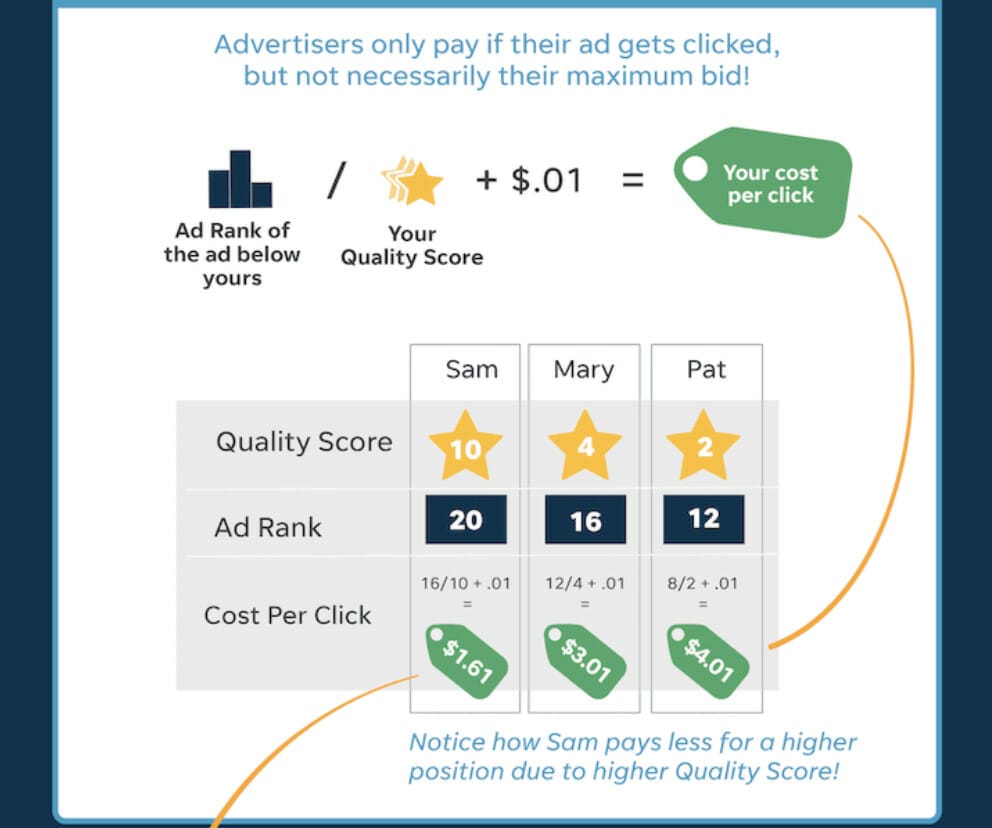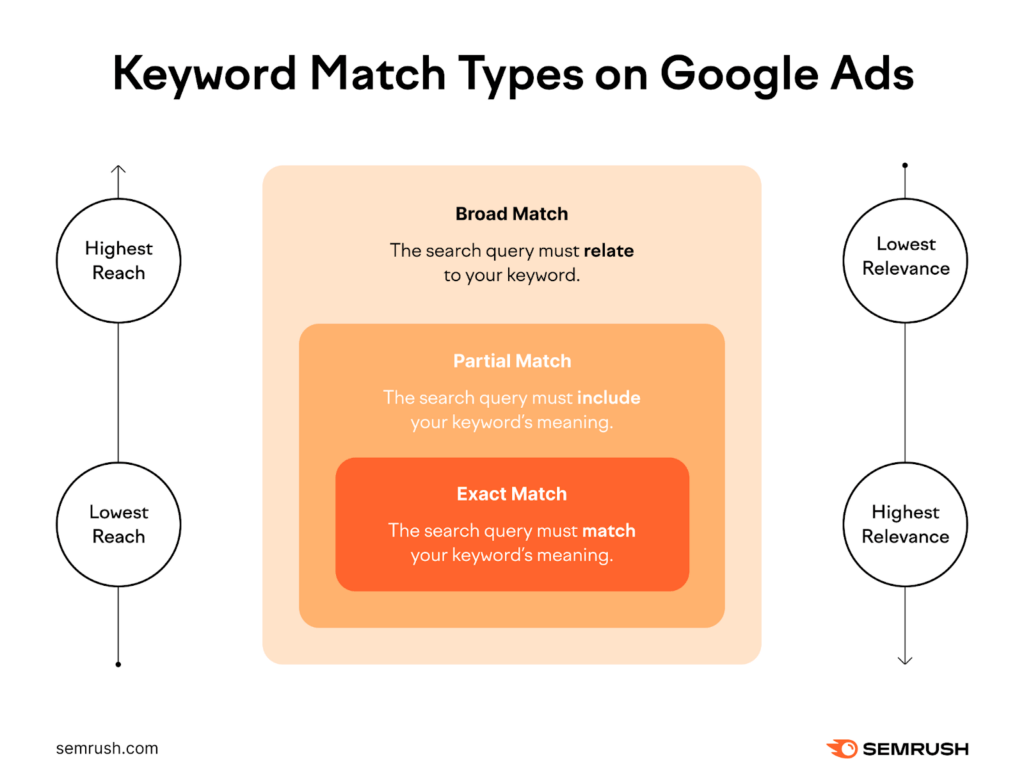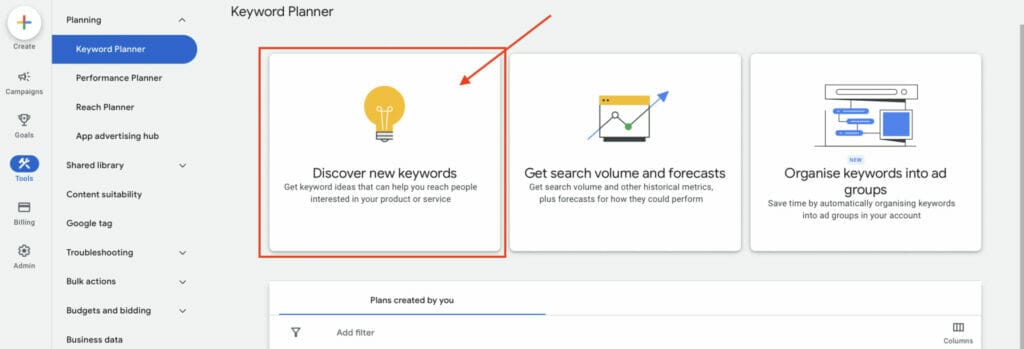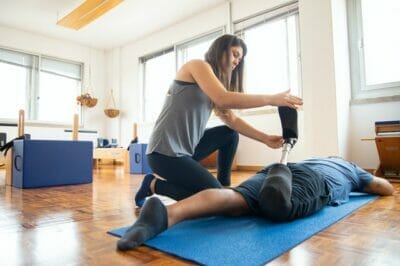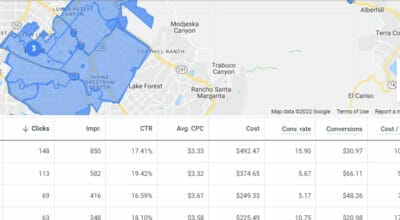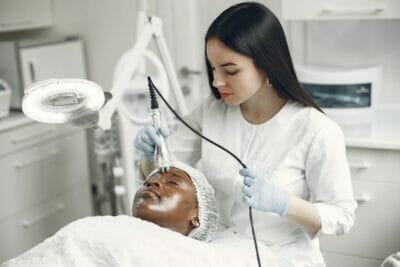With Google Ads being the top digital marketing platform for many businesses to increase visibility, leads, and revenue, it is the online marketing strategy you need for your junk removal business!
Online advertising plays a critical role in driving business growth in today’s digital landscape. In this article, we will go through a step-by-step guide to creating a successful campaign on Google ads for junk removal businesses to bring you your desired results.
Table of Contents
ToggleGoogle Ads vs SEO
Google Ads (previously known as Google AdWords) will enable your junk removal business to connect with your target audience, drive traffic, and increase conversions. Because of its powerful capabilities, like targeting and reach, Google Ads has become one of the top advertising tools for all businesses to grow and succeed in digital advertising.
Creating Google Ads for Junk Removal Businesses will enable your business to be seen at the top of SERP, which means that you won’t have to work hard to outrank your competitors in organic search results, increasing brand visibility and reach for your business.
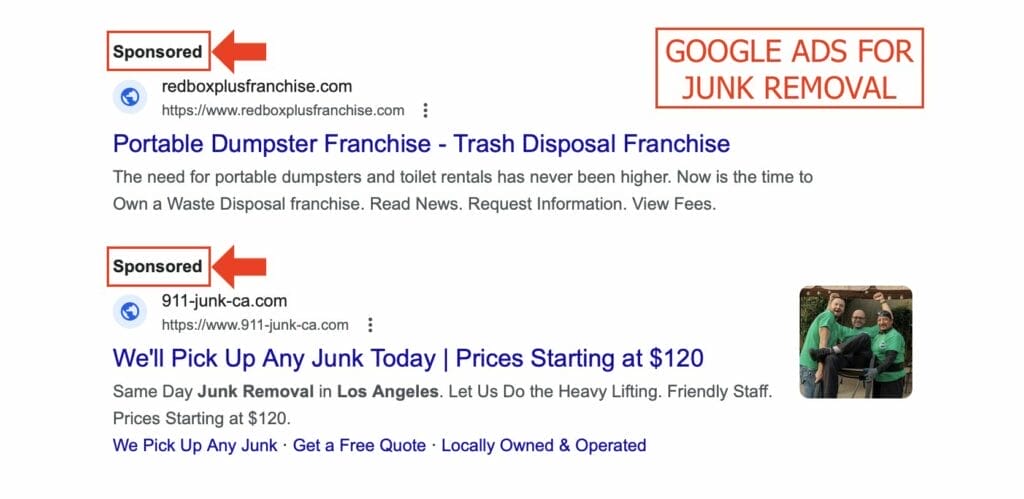
SEO or Search Engine Optimization are the organic results on SERP or search engine results pages that usually appear right underneath Google Ads. This is another effective strategy to help grow your junk removal business, but SEO can take a long time (from 6 to 18 months) before you start seeing long-term results.
If you want faster, effective results with your digital advertising strategy, Google Ads for Junk Removal Businesses is your best option. If you’re unsure about choosing Google Ads or SEO for your business, learn more here.

Part 1. Google Ads for Junk Removal Businesses
1.1 Google Ad Structure
Google Ads follows a simplified structure consisting of the following components:
- Account: This is the highest level of organization in Google Ads. It represents your overall advertising account and contains all your campaigns, ad groups, and ads.
- Campaign: A campaign is a specific advertising initiative with its own budget, settings, and targeting options. You can create multiple campaigns within your account, each with its own objective and strategies.
- Ad Group: Within each campaign, you create ad groups. An ad group contains a set of related ads and keywords. It allows you to organize your ads based on themes or target audience segments.
- Ads: Ads are the actual advertisements that users see when they search on Google or browse websites within the Google Display Network. You create and customize your ad copy, including headlines, descriptions, and display URLs, to attract users and drive clicks.
- Keywords: Keywords are the search terms or phrases that you target with your ads. They determine when your ads are displayed to users. You select relevant keywords that align with your business and target audience.
- Targeting: Google Ads provides various targeting options to reach your desired audience. You can target users based on factors like geographic location, language, device type, and specific demographics. This helps you focus your ads on the most relevant audience.
- Budget and Bidding: You set a budget for each campaign, which determines how much you are willing to spend on your ads. Bidding refers to the process of setting the maximum amount you are willing to pay for each click on your ads. Google Ads offers different bidding strategies to optimize your campaign performance.
- Tracking and Measurement: These are measurement tools in Google Ads to monitor the performance of your campaigns. You can track metrics like impressions, clicks, conversions, and costs to evaluate the effectiveness of your ads and make data-driven optimizations.
By understanding these key components of a Google ads structure, you can organize and manage your campaigns effectively to reach your target goals and improve the performance of your Google Ads.
Ready to start your Marketing Success?
1.2 Google Ad Campaign Cost
The cost of a Google Ads campaign can vary depending on several factors, including your industry, competition, target audience, and campaign settings. Here are some key points to understand how the cost of a Google Ads campaign is determined:
- Ad Auction: Google Ads operates on an auction system, where advertisers bid for ad placements. The cost of your campaign is influenced by the bids of other advertisers competing for the same keywords and target audience. Higher competition often results in higher costs.
- Bidding Strategy: Your bidding strategy determines how much you are willing to pay for each click (CPC) or for a specific action like a conversion (CPA). Different bidding strategies have different cost implications. For example, if you choose a strategy that aims for maximum clicks, you may have a higher CPC compared to a strategy focused on maximizing conversions.
- Targeting and Competition: The specific targeting options you choose, such as geographic location, demographics, or interests, can impact the cost of your campaign. Additionally, the level of competition in your industry and the popularity of your targeted keywords can influence costs. Highly competitive industries generally have higher costs per click.
- Quality Score: Google assigns a Quality Score to your ads and keywords based on their relevance and performance. Higher Quality Scores can lead to lower costs and better ad positions. By improving the quality and relevance of your ads and landing pages, you can potentially lower your cost per click.
- Ad Relevance and Quality: The relevance and quality of your ads also play a role in cost. Google rewards advertisers with high-quality, relevant ads by offering better positions and lower costs. It’s important to create compelling and well-optimized ads that align with your target keywords and audience.
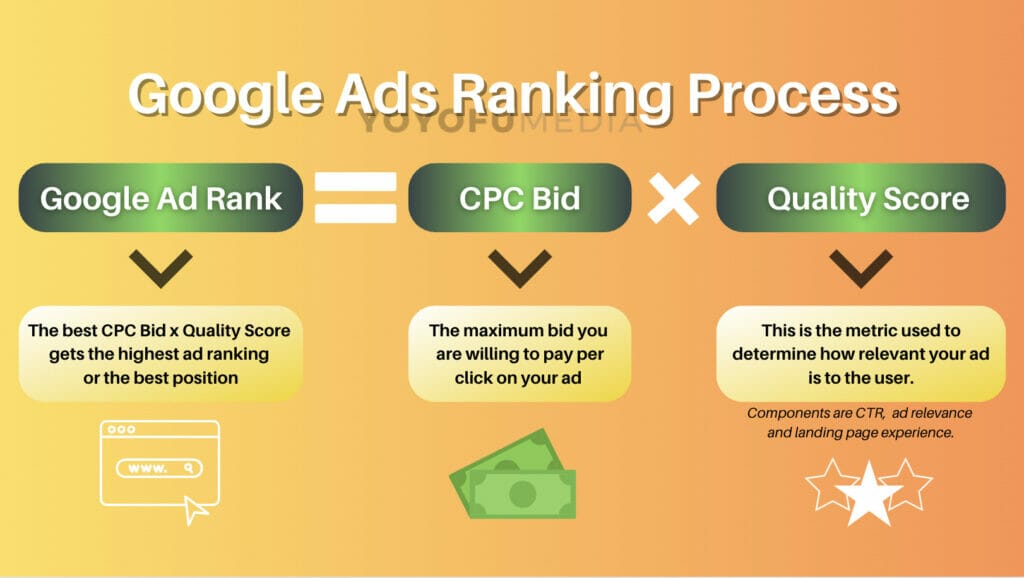
- Campaign Budget: The overall budget you set for your campaign will determine your spending limit. Google Ads allows you to set a daily budget, which controls how much you spend on average per day. It’s essential to set a budget that aligns with your advertising goals and financial capabilities.
Although you have control over your bidding strategy and budget, the cost of Google Ads can fluctuate over time due to various external factors, It’s advisable to continuously monitor your campaign’s performance, make data-driven optimizations, and adjust your budget and bidding strategy as needed to maximize your return on investment.
1.3 Key Features and Benefits
Google Ads offers a range of key features and benefits that empower advertisers to reach their target audience effectively and achieve their advertising goals. Let’s explore some of these features and benefits in detail:
Advertising Options
- Search Ads: These text-based ads appear on Google search engine results pages (SERP) when users search for relevant keywords, allowing advertisers to capture users’ intent and drive website traffic.
- Display Ads: These visually appealing image or video ads are shown on websites and mobile apps within the Google Display Network, reaching a vast audience and increasing brand visibility.
- Video Ads: With video ads on YouTube and partner sites, advertisers can engage users through compelling video content and storytelling, leveraging the popularity of online video consumption.
- Shopping Ads: Ideal for e-commerce businesses, shopping ads display product images, prices, and store information, enabling users to discover and purchase products directly.
- App Promotion Ads: These ads promote mobile apps across Google’s networks, encouraging downloads and driving user engagement.
Targeting Capabilities
- Location Targeting: Advertisers can specify geographic locations where their ads should be shown, ensuring their message reaches the right audience in specific regions or areas.
- Demographic Targeting: Advertisers can target their ads based on demographics such as age, gender household income, and more, reaching their desired audience segments.
- Interest-based Targeting: Google Ads leverages user browsing behavior and interests to serve ads relevant to users’ preferences, enhancing ad effectiveness and engagement.
- Keyword Targeting: Advertisers can select specific keywords related to their products or services, allowing their ads to appear when users search those keywords, capturing high-intent traffic.
Flexibility and Control
- Campaign Settings: Advertisers have control over campaign parameters such as budget, start and end dates, and scheduling, and ad delivery options, providing flexibility in campaign management.
- Budget and Control: Advertisers can set daily budgets and allocate their advertising spend based on their objectives, ensuring they have control over their costs and maximum spending limits.
- Bidding Strategies: Google Ads offers various bidding strategies, including manual bidding and automated bidding, empowering advertisers to optimize their bids based on their goals and target outcomes.
These features and benefits of Google Ads collectively provide powerful platforms to reach their target audiences, drive traffic and conversions, and achieve their advertising objectives. The extensive advertising options, robust targeting capabilities, and flexibility in campaign management make Google Ads a versatile and effective tool for businesses of all sizes.
Want us to take over from here?
Part 2.The Importance of Google Ads for Junk Removal Businesses
Google Ads offers powerful targeting options and customization features that are instrumental in driving the success of your junk removal business. Here’s why targeted advertising and customization are crucial:
2.1 Audience Targeting: With Google Ads, you can target specific audiences based on factors such as location, demographics, interests, and keywords. By understanding your ideal customer profile, you can refine your targeting parameters to reach the right audience for your junk removal business services. For example, you can target homeowners in your service area who are likely to require junk removal assistance.
2.2 Customized Ad Campaigns: Google Ads provides customization options to tailor your ads to different segments of your target audience. You can create multiple ad variations and landing pages that resonate with different customer segments. This customization enhances the relevance of your ads, increasing the chances of engagement and conversions.
2.3 Data-Driven Optimization: Google Ads offers robust analytics and performance metrics that provide valuable insights into your campaigns. By analyzing data such as impressions, clicks, conversions, and cost per click (CPC), you can make data-driven decisions to optimize your campaigns. You can identify high-performing keywords, ad variations, or targeting parameters and allocate your budget accordingly, improving the overall performance of your campaigns.
2.4 Ad Assets: Google Ads allows you to enhance your ads with assets that provide additional information and options for users. For a junk removal business, ad assets like call assets, sitelink assets, or promotion assets can be valuable. These extensions increase the visibility of your ads, provide more context to potential customers, and encourage them to take action.
2.5 Ad Scheduling: With Google Ads, you have the flexibility to schedule your ads to appear at specific times or days of the week. This allows you to align your ad exposure with the times when your target audience is most likely to be searching for junk removal services. By displaying your ads at the right moment, you maximize the chances of reaching potential customers when they are actively in need of your services.
By leveraging targeted advertising and customization features in Google Ads, you can refine your campaigns to reach the most relevant audience, tailor your messaging to resonate with different segments and optimize your ads based on performance insights. This level of customization and optimization empowers your junk removal business to deliver highly targeted and effective advertising campaigns, ultimately driving better results and return on investment.
Need help getting started?
Part 3. Getting Started with Google Ads for Your Junk Removal Business
3.1 Account Setup and Campaign Creation
Step 1: Sign up for Google Ads
Visit the Google Ads website, ads.google.com, and click on “Start Now”. You can create an ads account using existing Gmail or any email address.
 Step 2: Choose your campaign goal based on your junk removal business objectives
Step 2: Choose your campaign goal based on your junk removal business objectives
Once you have successfully set up your account, you’ll see different campaign objectives. To have more flexibility, choose “Create a campaign without Google’s guidance”.
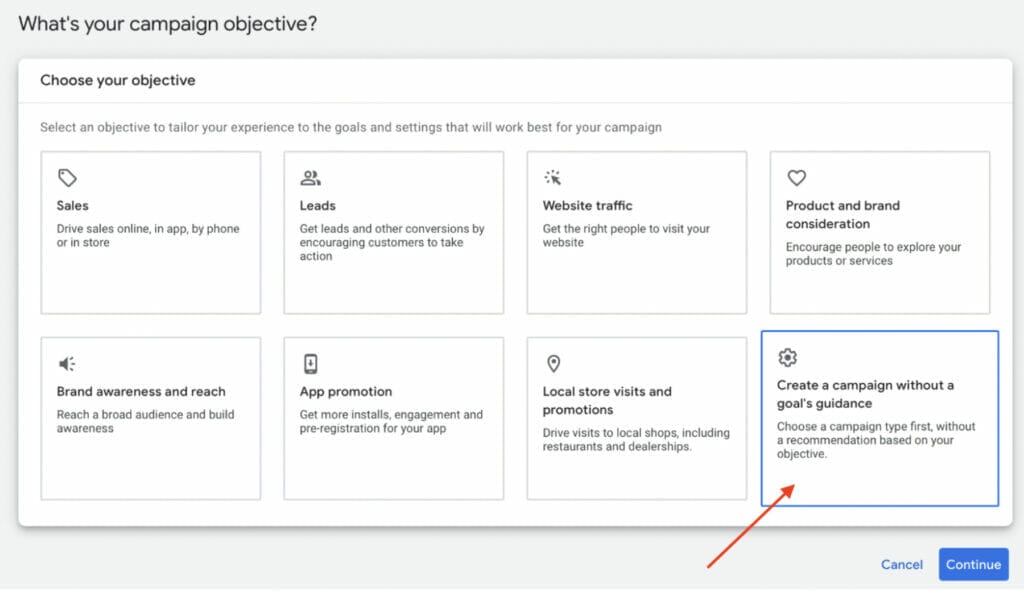
Step 3: Campaign Type
Choose a campaign type that aligns with your goals. For junk removal, you can start with a Search type campaign to display text ads on Google search results.
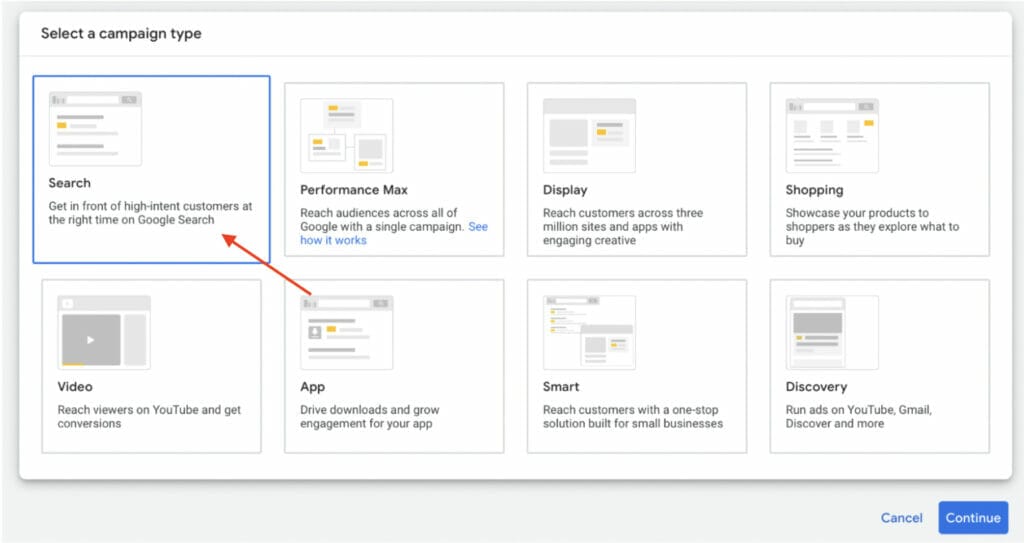
Step 4: General Settings
Skip the next section, and then type in your chosen Campaign Name.
Choosing Campaign Name
The Campaign Name serves as an identifier for your campaign and helps you organize and differentiate it from other campaigns you may have.
Here are some tips for choosing an effective campaign name:
- Be descriptive: Choose a campaign name that clearly reflects the purpose or theme of your campaign. For a junk removal business, you can include relevant keywords or descriptors like “Junk Removal Services” or “Residential Cleanouts”.
- Keep it concise: Try to keep the campaign name relatively short and concise. Long campaign names can be challenging to manage and may not fit within certain reporting or display areas.
- Be Unique: Ensure that each campaign name is unique within your Google Ads account. This helps prevent any potential conflicts or mix-ups when managing and analyzing campaign performance.
Remember that the campaign name is for internal reference purposes only within your Google Ads account and is not visible to users who see your ads. Focus on creating a campaign name that helps you easily identify and understand the purpose of your campaign when reviewing your account or running reports.

Choosing Network Settings
When setting up a Google Ads campaign for your junk removal business, one of the important settings to consider is network targeting. The network targeting determines where your ads will be displayed. Under the “Networks” section, you’ll have two options: “Google Search Network” and ‘Google “Display Network”.
a. Google Search Partner Network:
This option allows your ads to appear on Google’s search partner results when users search for keywords relevant to your junk removal business. Selecting this option will make your ads show up to users actively searching for junk removal services, and even on Google’s partner search engines and product pages.
b. Google Display Network:
This option enables your ads to appear on websites, mobile apps, and other platforms that are a part of Google’s Display Network. These ads can be in the form of text, image, or video ads. Display Network ads can help increase your reach and brand visibility by displaying your ads to a broader audience.
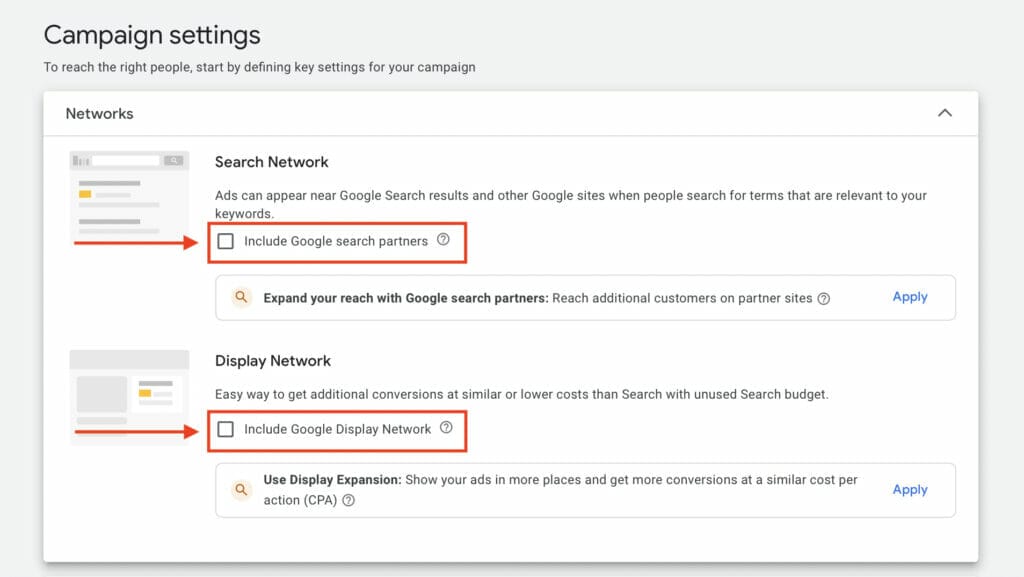
For a junk removal business, it’s recommended to leave both network options unchecked but you can always expand your campaign to the Google Display Network and Google Search Partners later if you want to explore additional advertising opportunities.
You want to leave both network options unchecked because you don’t want your ad to show up on Google’s search partners when people aren’t actively looking for your products or services. This also applies to why we won’t select Google’s display network since we chose search as our campaign type.
Step 5: Targeting Location, Language, Demographics, Exclusions
Google Ads offers different targeting options:
a) Targeting by geographic area: You can select specific areas where you want your ads to be shown. For example, if your junk removal business operates in Los Angeles, you can target the city of Los Angeles or nearby areas where you provide services.
- Target Location: Specify the geographic locations where you offer junk removal services. This ensures your ads are shown to users in relevant areas. Click “Advanced Search” to be able to filter specific target locations.
- Radius Targeting: On the other hand, if your junk removal services cover a specific radius around your business location, you can enter the desired radius distance, such as 10 or 20 miles. This option allows you to target users within that radius.

In the search box, enter the specific locations where you want to target your junk removal services. You can even choose how far you are willing to travel to offer your products and services to your potential new customers using the radius feature. In this example, we entered a 15-mile radius for our location targeting.
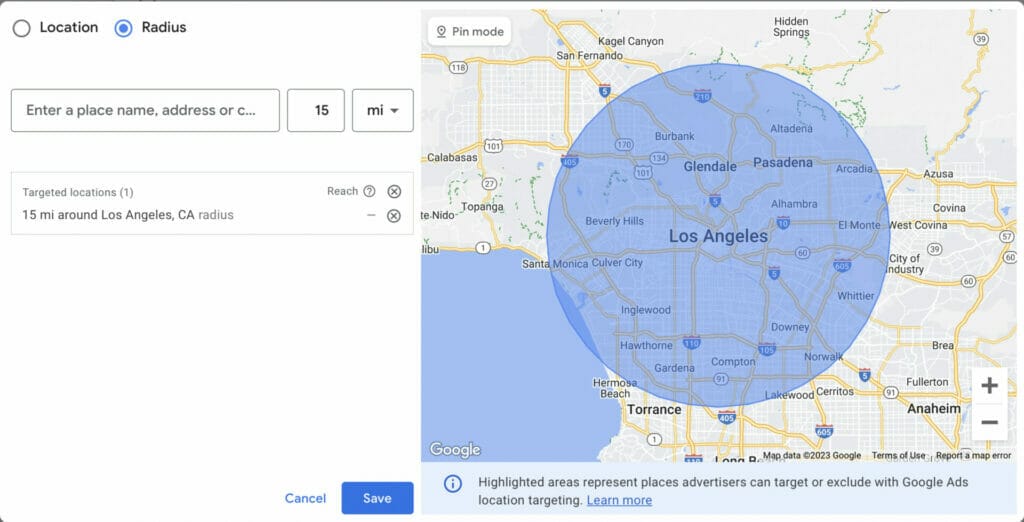
b) Location exclusions:
If there are certain areas where you don’t want your ads to be shown, you can add them as exclusions in advanced search. This is helpful if your junk removal business doesn’t serve certain locations or if you want to focus your advertising efforts on specific areas.
Audience segments:
You can also refine your targeting further by using additional demographic, interest, or behavior-based targeting options available in the ‘Audience Segment’ section. This allows you to reach users who match specific criteria, such as homeowners or individuals interested in home improvement.

When using the Audience Segment setting, ensure that the “Observation” setting is selected. This way your reach won’t be limited by audience segments, and you can implement different strategies to work along with your audience targeting.
c) Language
Under the “Languages’ section, enter the specific language your target audience will most likely use. This should be the language your business operates in. If you want to have your junk removal business advertised in multiple languages, we strongly recommend creating a different ad campaign per language.

Step 6: Ad Scheduling, Budgeting and Bidding
When setting up a Google Ads campaign for your junk removal business, it’s important to configure ad scheduling, budgeting, and bidding settings to effectively manage your campaign. Here’s a breakdown of each setting:
Ad Scheduling:
- allows you to specify the days and times your ads should be shown to your target audience
- analyze your campaign performance data to identify the times of the day or days of the week when your ads receive the most clicks or conversions
- adjust your ad scheduling to increase bids and show your ads during those high-performance periods
- for example, you might find that weekends or evenings generate more inquiries for your junk removal services, so you can increase bids during those times

Budgeting and Bidding:
- set a daily or monthly budget for your campaign to control your advertising costs
- determine how much you are willing to spend each day or month on your Google Ads campaign
- consider factors such as your business capacity and advertising goals when setting a budget
- ensure your budget is realistic and aligns with your desired results
- determine how much you are willing to pay for each click on your ads or for other desired actions, such as conversions or impressions.
- consider your campaign objectives and budget when selecting a bidding strategy. The popular option is CPC (Cost Per Click) bidding
- monitor your campaign performance regularly and adjust your bids accordingly to maximize the performance of your ads.
- use bid adjustments to fine-tune your bidding based on factors like device type, location, or time of day.
3.2 Bidding and Manual CPC for Junk Removal Business
For this campaign, select Clicks as the main bidding focus. You can check the maximum cost-per-click bid limit and enter an amount if you want to have more control over your ad spending. Make sure that in the customer acquisition section, it is left unchecked so you can target both new customers and returning customers.

For your manual CPC, you want to enter a daily budget amount for your campaign. You don’t want to enter an amount that is too low, since it may not give you your desired results, and this will not give you enough measurable data that will help improve your ads in the long run. You want to start with a budget between $30 to $50, and for this example, we will enter $35.
In your manual CPC settings, you will also get a mini breakdown of the expected performance based on your budget, such as expected weekly clicks, weekly cost, and average CPC. Keep in mind that these are just estimates of how your ad could perform.

Save your settings and proceed with creating your ad groups, keywords, and ad creatives to launch your campaign. Remember to regularly monitor the performance of your campaign and make adjustments to your targeting settings if needed. This can help you optimize your ads’ reach and ensure you’re reaching the right audience for your junk removal service.
Step 7: Ad Group and Keyword Research
Keyword research plays a vital role in the success of your Google Ads campaign for your junk removal business. It involves identifying and selecting the right keywords that are relevant to your business and target audience. Here’s why keyword research is important and how it impacts the relevance and visibility of your ads, along with some tips and tools to help you conduct effective keyword research.
- Start with Seed Keywords: Begin your keyword research with a few broad terms related to junk removal, such as “junk removal service” or “trash removal company”. These seed keywords will form the basis for expanding your research.
- Competitor Analysis: Conduct a thorough analysis of your competitors’ websites and landing pages to identify the keywords they are targeting. Look for specific phrases, terms, or industry-related keywords that are frequently used in their content. This analysis can help you generate ideas for relevant keywords to include in your own campaigns.
In the Ad Group and Keyword settings, enter the name of your ad group and then your keywords which should have been researched prior to creating your ad campaign. In this example, we’ve named our ad group Junk Removal LA California and entered keywords that people usually search for on Google’s search bar that are in relation to junk removal services.
When entering your keywords, make sure that these are formatted into keyword match types, which are the key terms that will trigger your ad to show up on a user’s search results page.
Keyword Match Types
Formatting keywords into keyword match types is critical because it will help you set up your ad to focus on keywords that work, attract the right visitors to your website, and control how and where your ad will appear in a given search query by a user. Here are the keyword match types used for Google Ads:
- Broad Match: These are terms or queries that relate to your chosen keywords
- Phrase Match: These are terms or phrases that are similar to your keywords or include the same meaning. Phrase Match keywords must always be formatted in quotation marks ” “.
- Exact Match: These are terms that are the exact same keywords, or extremely close variations of that keyword with the same meaning. Exact Match keywords are always encased in brackets [ ].
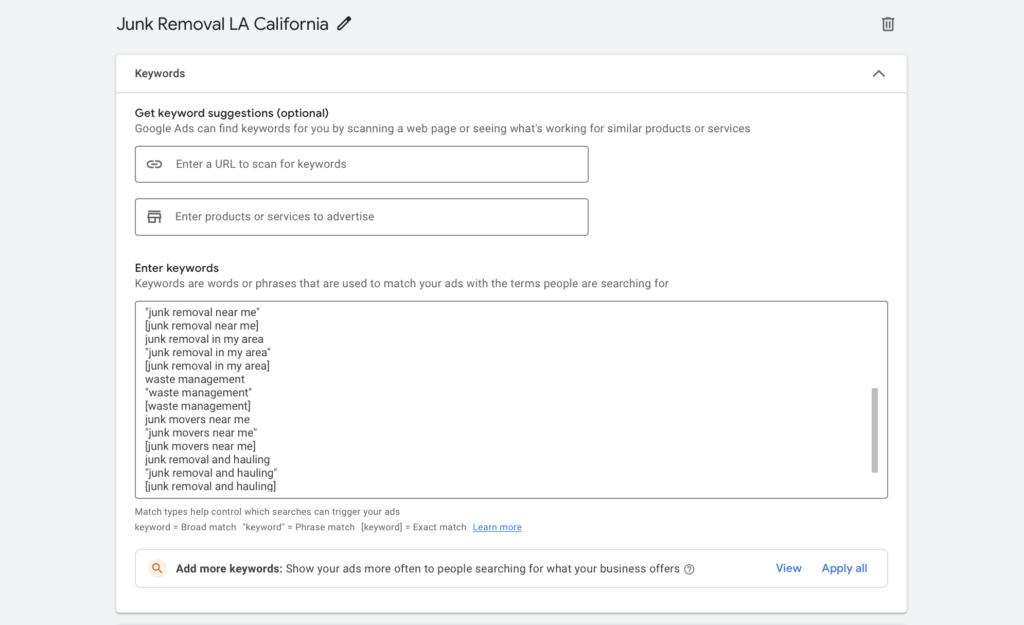
Keyword Research Tools
- Utilize keyword research tools like Google Keyword Planner, Free Keyword Match Type Tool, and Negative Keyword Pro
Example: Keyword Search using Free Keyword Match Type Tool
- After extracting seed words, paste them into the Keyword Match Tool.
- Select the keywords that are most relevant to your junk removal business and add them to your keyword list. You can filter or sort the keywords based on different criteria offered by the tool, such as broad match, “phrase match,” and [exact match].
- Once you have finalized your keyword list, copy the results.
- Take the keywords you’ve selected and apply them to your Google Ads campaign. Ensure that you organize them into relevant ad groups and align them with appropriate ad copy and landing pages.
Step 8: Choosing Headlines
When setting up a Google Ads campaign for your junk removal service, creating compelling headlines is crucial to attract attention and drive clicks. Here are some examples for creating effective headlines:
Final URL and Display Path
Enter your website’s URL in the Final URL section, and include key terms in the Display path in relation to what you are advertising. The display path key terms give the user an idea of where they will be taken to, once they click on your ad.
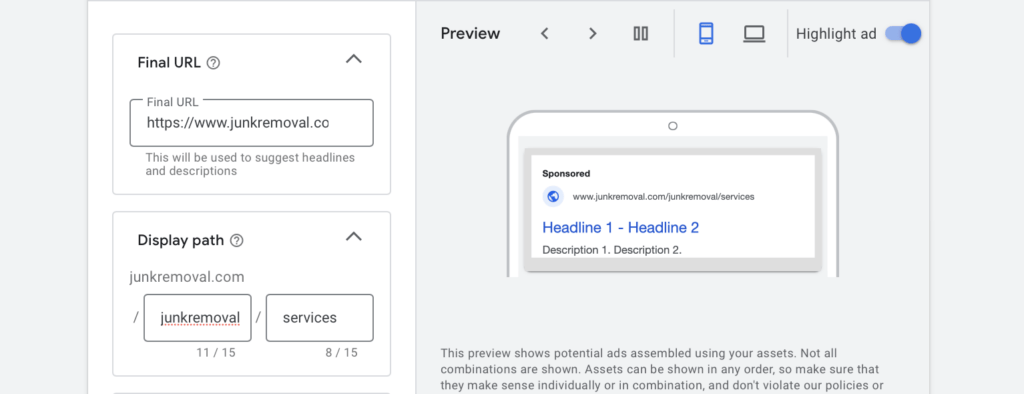
Headlines
When creating headlines for your Google ads for a Junk Removal Business, you want to consider a few factors to ensure you grab the attention of your potential new customers.
- Be Clear and Specific: Clearly convey what your junk removal service offers in the headline. Use specific terms like “Professional Junk Removal Service in LA” or “Quick and Reliable Junk Removal in California”. This helps users understand your offering right away.
- Highlight Unique Selling Points: Identify the unique features or benefits of your junk removal service and incorporate them into the headlines. For example, “Same-Day Junk Removal Services” or “Affordable Eco-Friendly Junk Removal”.
- Use Numbers or Statistics: Including numbers or statistics in your headlines can make them more compelling. For instance, “99% Customer Satisfaction Rate” or “Over 10,000 Satisfied Customers”.
- Create a Sense of Urgency: Encourage users to take immediate action by incorporating words that create a sense of urgency. For example, “Limited Time Offer: Book Your Junk Removal Today!” or “Get Rid of Clutter Now!”
- Incorporate Relevant Keywords: Include relevant keywords related to junk removal in your headlines. This helps increase the relevance of your ads to users’ search queries. For example, “Junk Removal Experts in LA” or “Hassle-Free Residential Junk Removal”
- Follow Google Ads Character Limits: Ensure that your headlines adhere to Google Ads’ character limits. Currently, the limit is 30 characters for each headline. Make the most of this limited space to convert your message effectively.

Remember to align your headlines with the overall messaging and value proposition of your junk removal service. Your headlines should be concise, attention-grabbing, and relevant to the needs and interests of your target audience. Regularly review and optimize your headlines based on performance data to improve your ad campaign’s effectiveness.
Descriptions
In the descriptions section, you want to focus on including information highlighting why your junk removal business is better than your local competitors. For example, you can include key information such as “With Over 50 years of Experience by Junk Removal Experts” if you’ve been in the industry for more than a few years.

Ad Assets
Next, always include some type of ad assets in your Google ads campaign. Ad assets help make your ad stand out more by appearing bigger on Google’s Search Result pages. One of the ad assets we recommend including is sitelinks.
Sitelinks act as links to specific landing pages of products or services offered by your junk removal business. This will encourage your website visitors to convert and purchase what you are offering.

To add sitelinks, click on “+Sitelinks” and then click on “Create”.

When creating your sitelinks, these should be very specific keywords in relation to your ad campaign, and you can add up to 4 sitelinks per ad group. For example, you can have sitelinks such as ‘Book An Appointment” or “Full Junk Removal Service”. In each sitelink, you will need to include 2 descriptions relevant to the sitelink text, and the final URL should be the landing page for that specific offer.
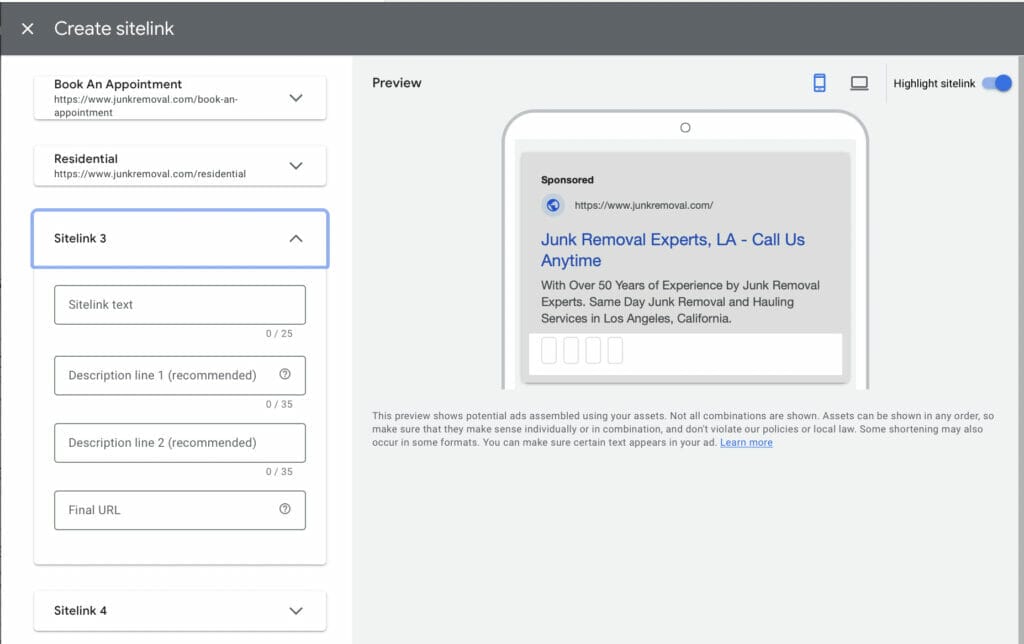
Once you have created all 4 of your sitelink assets, make sure you select them then click on ‘save’ to add them to your ad group.
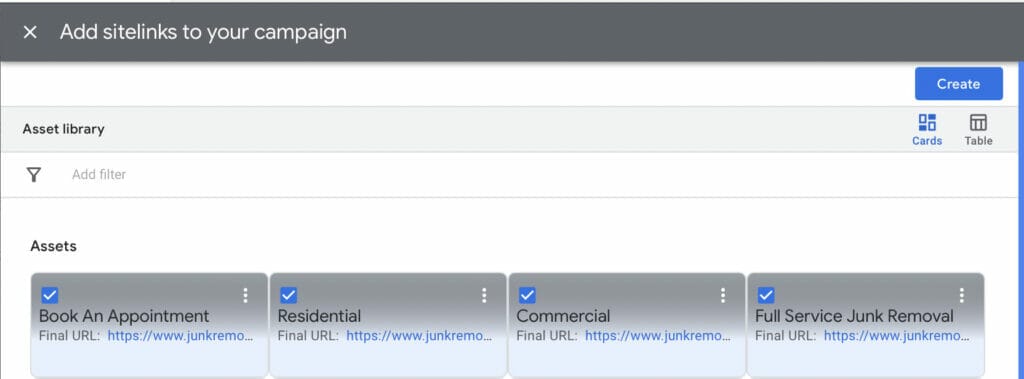
Step 9: Billing Set-up
During the billing stage of setting up your Google Ads campaign, you will need to configure your billing settings and provide payment information. Here’s a step-by-step guide to help you through this process:
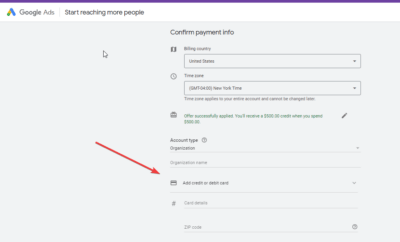
- Access Google Ads Billing: Sign in to your Google Ads account and navigate to the Billing section. You can usually find it by clicking on the gear icon in the top corner and selecting “Billing & Payments or a similar option.
- Choose Billing Country and Time Zone: Select the country in which your billing address is located. Choose the appropriate time zone associated with your business location.
- Add Payment Method: Enter your payment information. Google Ads accepts various payment methods, including credit or debit cards, bank accounts, or direct debit. Provide the required details, such as card number, expiration date, and billing address.
- Set Budget and Payment Cap: Specify your daily budget or overall campaign budget. This ensures that your ad spend doesn’t exceed the desired amount. You can also set a payment cap to control your total spending within a specified timeframe.
- Review and Confirm: Double-check your billing information, payment method details, and budget settings. Ensure everything is accurate before proceeding.
- Accept Terms and Conditions: read and accept the terms and conditions related to billing and payments. This includes understanding Google’s policies and agreements.
- Save and complete: Once you have reviewed and confirmed all the details, click the “Save” or “Complete” button to finalize your billing setup.
- Verify Billing Setup: After saving your billing settings, Google Ads may require you to complete a verification process. This can involve confirming your payment method or providing additional information for security purposes.
It’s important to note that the billing process may vary depending on your location, account type, and specific requirements. Make sure to follow any instructions provided by Google Ads during the billing stage to ensure a smooth setup process.
Once you have sorted out all your settings for your Google ads for junk removal business campaign, you will see what your ad looks like on Google’s search result pages, along with all the information you’ve included such as headlines, descriptions, final URL and the ad assets you’ve included.

Do you want to create Google Ads for your junk removal business, but you just don’t have the time? We make it easy for our clients!
Part 4. Google Dashboard Overview
Google Ads dashboard is a centralized interface where advertisers can manage and monitor their Google Ads campaign. It provides a comprehensive overview of campaign performance, account setting, and various metrics. It offers a range of features and tools to manage, monitor, and analyze your campaigns, helping you achieve your marketing goals.
Here’s a brief explanation of what you can find on the Google Ads dashboard:
- Campaign Overview – displays an overview of your active campaigns, including metrics such as impressions, clicks, conversions, and costs. You can see the performance of each campaign at a glance.
- Performance Metrics – provides key performance metrics, including click-through rate (CTR), average cost per click (CPC), conversion rate, and total spend. These metrics help you evaluate the effectiveness and efficiency of your campaigns.
- Account Settings – access and manage various account settings from the dashboard. This includes billing information, payment methods, notification preferences, and account access controls.
- Ad Groups and Keywords – allows you to view and manage your ad groups and keywords. You can monitor the performance of individual ad groups and make adjustments to keyword targeting and bids.
- Ad Copy and Assets – review and edit your ad copy, including headlines, descriptions, and display URLs, directly from the dashboard. Additionally, you can manage ad assets, such as sitelinks or call assets, to enhance your ad’s visibility and engagement.
- Targeting and Audience – provides options to define and adjust your targeting settings. Includes geographic targeting, language preferences, device targeting, and audience targeting options.
- Conversion Tracking – can set up and track conversions on the dashboard. Allows you to monitor the number of actions taken by users, such as from submissions, phone calls, or purchases, and attribute them to specific campaigns or keywords.
- Reports and Insights – offers reporting features to generate customized reports on campaign performance and trends. You can access pre-built reports or create your own to analyze data and gain insights.
- Recommendations – Google Ads may provide recommendations and insights based on your campaign performance. These suggestions can help optimize your campaigns and improve their effectiveness.
Ready to take the next step?
Part 5. Optimizing your Google Ads Campaign
5.1 Keyword Planner
As mentioned earlier, one of the tools you can use for your keywords is Google’s Keyword Planner. It is one of the best features available on your Google Ads dashboard to help optimize your advertisement. With Keyword Planner, you get insight data on specific keywords such as their average monthly searches, how competitive that keyword is, and their top-of-page bids.
To access Keyword Planner, simply go on “Tools”, then click on “Discover New Keywords”.
Enter keywords relevant to your Google ads campaign, for instance: junk removal or junk removal services. Click “Get Results”.
After clicking on Get Results, you will see all the keywords that show up in relation to the keywords you entered. You will also see which keywords are already in your ad group on the right side of the table, under Account status.
From these keywords, you can select the ones you want to add to your ad campaign, and you can even select those you want to add to your negative keyword list.
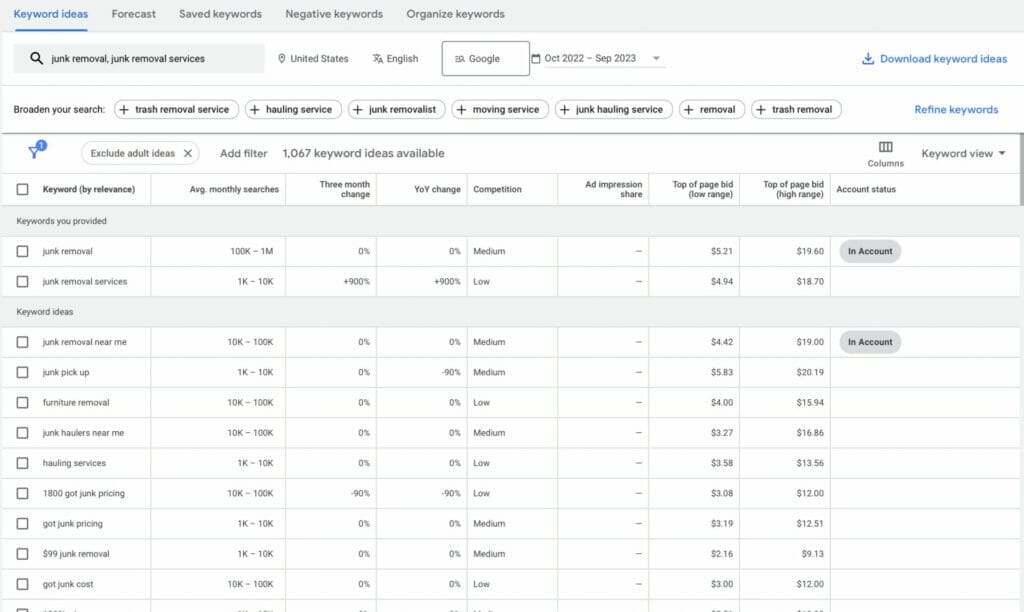
5.2 Negative keywords
There will be cases where you don’t want your ads to show up or be triggered by some search queries. For instance, you want your ad to show up to a user actively searching for your products and services, not on a search query for someone who is simply doing research about your niche or industry. That’s where negative keywords come in. These are keywords that will exclude your ad from a certain search.
To access negative keywords from your Google Ads dashboard, go to “Search Keywords” then click on “+Negative Keywords”.
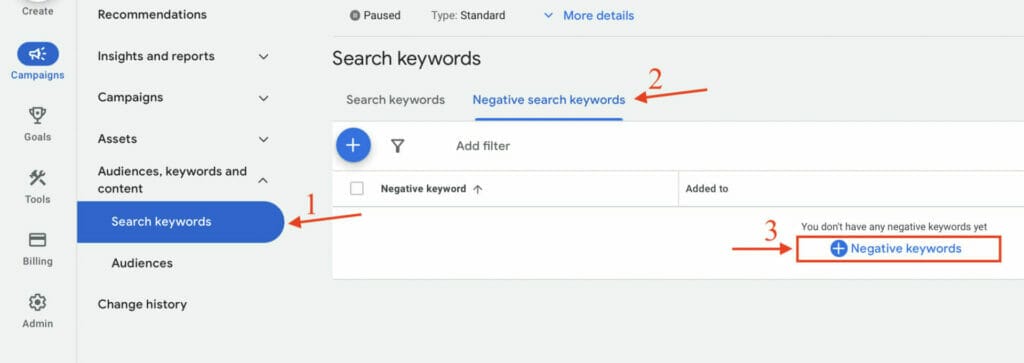
Add your negative keywords to the text box. You can use these for cities or services that your clinic is unable to serve, or even keywords for items that your junk removal business can’t take, such as “Junk Removal of Paint”.

Click on “Save” and your negative keywords will have been added to your ad campaign.

5.3 Landing Page
A landing page is a stand-alone page designed with the purpose of convincing a website visitor to purchase a product or avail of the service offered by your junk removal business.
Your landing page needs to be relevant to your Google ads campaign and what is being advertised. Landing pages are essential for your junk removal business to get new potential customers; hence why these should be optimized using key elements that address the user’s fears and hopes, supporting copy and testimonials to earn the user’s trust, and multiple points of interaction such as CTA buttons and short lead forms.
Looking at this landing page example for a Full Service Junk Removal, you can see it already uses plenty of key elements for an optimized landing page experience for the user, such as using the Keywords in the Title, a Hero Shot to visually communicate the service being offered, a unique selling proposition, and multiple points of interaction through CTA buttons and a Short Lead Form.

It contains a section with Social Proof or Testimonials from previous customers, key benefits of using their service and supporting copy.
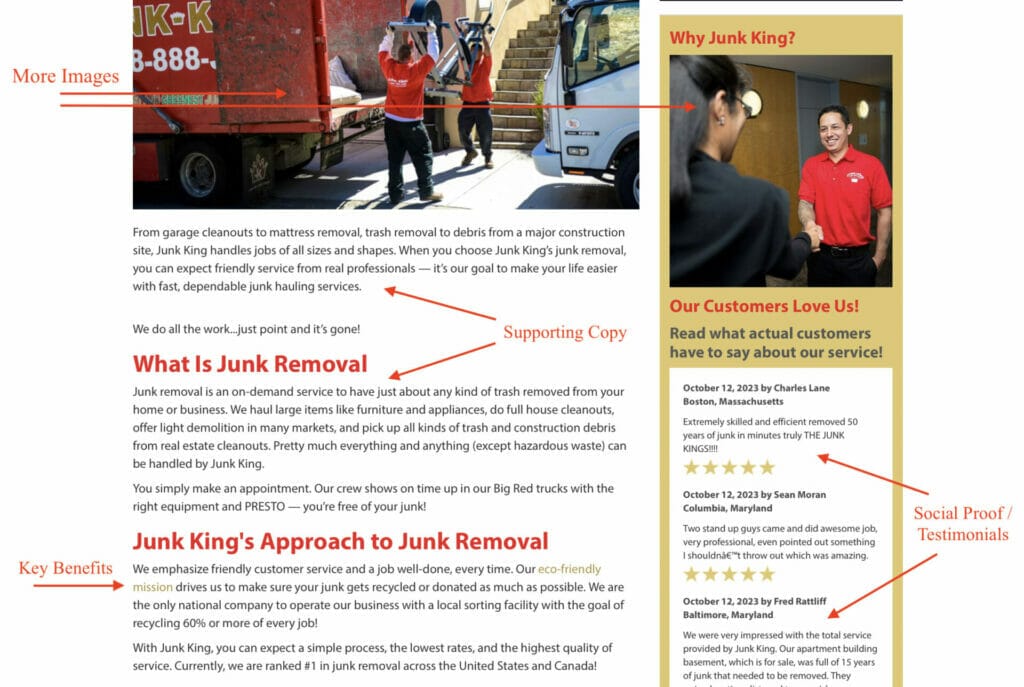
Additional supporting copy that reinforces the statement can be found on this landing page, which addresses the user’s fears and hopes (the user’s problems and the solution). There are further key benefits found at the end of the page, along with trust indicators of a 100% guaranteed quality service by the junk removal company.
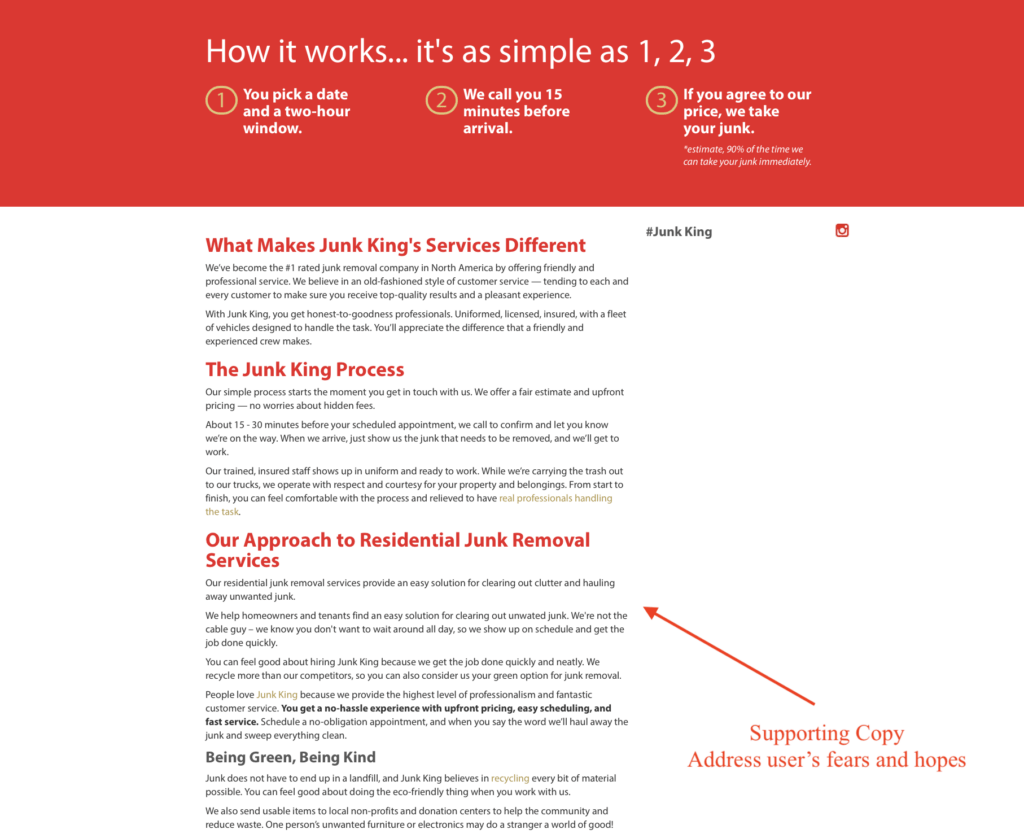

Do you need assistance optimizing your landing pages for better leads and conversions?
Part 6. Key Takeaway
Overall, Google Ads empowers junk removal businesses to target their audience effectively, generate leads, and achieve a strong online presence. By utilizing its features and optimizing campaigns based on data-driven insights, you can maximize your marketing efforts and drive business growth. Remember that Google Ads is an ongoing process of actively managing and continuously optimizing your campaign to improve its performance for better results and a higher ROI.
If you need assistance managing your Google Ads campaign, feel free to book an appointment with our team of friendly experts.
We’ve helped over 1,000 customers reach their target goals, and survived and thrived through 15+ Google algorithm updates so if you are still in doubt about the effectiveness of Google Ads for your Junk Removal Business, check out our successful case studies on Yoyofumedia’s Page.


